By Brian Cady
On February 27th in New York City, Guernsey’s Auction House will hold a daylong auction of over 300 collectible vintage guitars and music memorabilia. Included in the auction are items from George Benson’s personal collection, as well as items from several other amazing personal collections. Items will range from the personal guitars of world class musicians to vintage instruments from D’Aquisto, Martin, Fender, Gibson, D’Angelico, Gretsch, Epiphone and Benedetto—to name but a few. Guitars owned by Eric Clapton, Stevie Ray Vaughn, Ace Frehley, Franny Beeher (Bill Haley & The Comets) and Gordon Waller (Peter & Gordon) will be sold alongside an assortment of one-of-a-kind signed promotional guitars, drum heads and music awards. Simply put, there will be something for every music collector.
Elmore Magazine previously had the opportunity to cover Guernsey’s 2015 auction of Les Paul Memorabilia from the “Tom Doyle Collection’ – which saw Les Paul’s personal 1954 Les Paul Custom “Black Beauty” sell for $335,000, so in advance of this month’s upcoming auction, we jumped at the chance to sit down again with Arlan Ettinger, founder of Guernsey’s Auction House.
We met Ettinger in his Upper East Side office, surrounded by dozens of these amazing vintage guitars. The professorial auction house owner provided us with a fascinating insight into the world of music auctions.
Believe us—if you are a guitarist, you really want to be Arlan Ettinger.
Elmore Magazine: Guernsey’s is offering so many great guitars in this one auction; How did this auction come about?
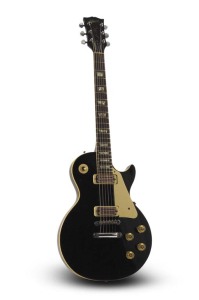
Arlan Ettinger: Auctions tend to develop in one of two ways. First, you have one person’s collection that is worthy of an auction in and of itself. That collection is a taste of that person. (EM: This was the case of the The Tom Doyle / Les Paul Auction.) But this sale we have coming up on February 27th is an example of one with multiple consignors. We didn’t start with one great collection, but instead we started when a few great guitars were offered to us. We determined this is a good start; it’s a good core of an event, but hardly a full-blown collection that we can build an event on. So we started doing what we’ve become known for doing: we networked and put the word out that Guernsey’s was doing an auction of guitars… and the rest is history, so to speak.
Having said that, it would not shock me if we got offers of some wonderful instruments the day before the auction. Where most firms wouldn’t consider late entries, I think it adds to the excitement and the fun. In my career I’ve found some of the best things have come to light at the last minute, and today the Internet makes it all easier.
EM: You have several substantial collections in this auction. Let’s first talk about George Benson’s collection.
AE: I had become friendly with George, and am privileged to know him. I met him when we were preparing for the Waylon Jennings country auction. He said that he had a bunch of guitars and wouldn’t mind in the next auction if we could sell them. I was honored, and that was certainly one of the events that got us going for this event.
EM: There’s also another collection?
AE: Yes, we have another collector with a dozen more lots from Florida. I had been introduced to the widow of Bob Yelin, jazz guitarist, teacher and writer of many books about guitars, and I started having conversations with her. She was excited about showcasing her husband’s collection but didn’t know how to go about it. She needed help, and I just thought that it was worth doing something that not too many heads of auction houses would do. So on impulse, I flew down to meet her. The collection meant a great deal to her… her husband treasured it, and the instruments were kept in pristine collection—we’re talking about a collection of more than 40 guitars. So although I could recommend shippers, I decided to rent a truck and personally drive her collection back to New York. I made one stop, to see the Lowenstein collection, pick up his guitars and then continued straight to New York. It was a great chance to get out from behind the desk!
EM: Obviously what’s particularly important in a vintage guitar auction is the provenance?
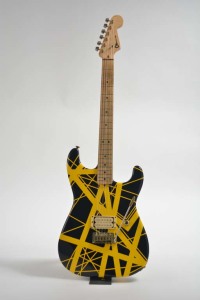
AE: Yes. But in one instance, we don’t have evidence to support what we were told by a consignor about the prior famous owner of a guitar. So while there’s some evidence to support this, there’s just not enough to make it conclusive. We may have the exact model of an instrument someone was photographed holding—and in this instance very few were made—and we evidence that an artist spoke about it, we just don’t want to say it.
On the other hand, we have the yellow and black guitar there in the corner [he points to a Charvel owned by Eddie Van Halen.] One of our experts this morning said that although the taping pattern was unique on every instrument and this one matches the pattern in a videotape of Eddie Van Halen the ’80s, and we have the actual bill of sale from Charvel to Eddie Van Halen, to further conclusively that it’s that instrument, you’d have to unbolt the neck and check the writing underneath. Which we did—and it was right.
EM: It seems like it can be an exhaustive process confirming the provenance of these guitars?
AE: We try our best. But you go back to George Benson… if George himself is giving you this guitar and says “Here, it’s mine” – do you dare say “Prove it?”
No, that would be absurd.
EM: You also have some guitars that may have been promotional items, signed by bands. And some Gold Records…
AE: The auction is being held in two sessions, over a full day that will go late into the evening. One collection was offered to us from the estate of a man in Delaware. It consisted primarily of guitars that weren’t owned or played by famous musicians, they were merely signed by them. I know that there are a lot of fans out there who will buy an inexpensive guitar, then go to a concert and wait for the signatures at the end. But for some people they make very exciting items, and I thought if we intermingle that collection with the other instruments, it would be a nice way to jump-start the event. It was all one man’s collection, and it has no reserve, every item will be sold. It makes for an exciting addition to the collection.
Think about this… you’re the father of a 12-year-old son. With these items in the sale, you might want bid one of these guitars for his room, or your den. But then you might also be interested in staying around and bidding on that D’Angelico over there for yourself. But we’re not suggesting that some inexpensive guitar that just happens to be signed by someone is the rival of one of these beautiful classic instruments!
EM: There is a pair of guitars in the auction called “The In Cold Blood” pair? It’s certainly a darker item… what kind of bidder to you think will go for that?
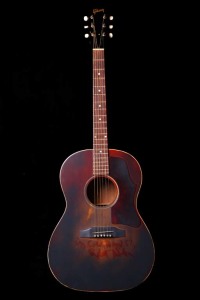
AE: It’s behind you… (He reaches over and opens two guitar cases…) I’m of an age that if you were to ask me about the movies that had the greatest impact on my life, In Cold Blood would be one of them. I’ve seen it several times and read the book twice. By anybody’s standards it is a masterpiece.
Certainly the murders were brutal, but you take away from that the mind of the killers, and the psychological impact. Perry Smith in particular of the two was the real case study, and the movie went into his childhood in great depth about what brought him to that point. So when offered to chance to sell both the guitar that he [actor Robert Blake] toted around in the movie and the real Perry Smith guitar in real life… Holy Smokes!
(He takes out both instruments… the Perry Smith guitar has his name painted on it in ornate script, while the 1961 Gibson from the movie is plain, worn and features Blake’s autograph)
Interestingly, the one in real life is far more decorative than the one in the movie… That’s the interesting thing. The study brought out that he was an artsy guy, but it’s sort of chilling when you know who has held it. And of course, to make it even more interesting, Robert Blake, who played Perry Smith, was later accused of murder. Included in the lot are some letters from Blake.
EM: What do you think will be the big seller?
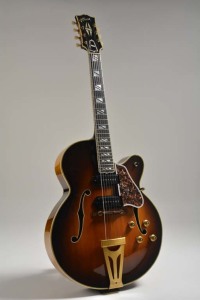
AE: I’ll tell you a story… We did both of the John F. Kennedy auctions and they had an unbelievable amount of coverage. Four days before one of the events a man called me from Louisiana and told me that he owned a boat that at one point had been owned by the Kennedy family—not necessarily JFK, but the family. It was sitting in a boatyard in Louisiana. As he put it, “It would sink faster than a stone if it ever got CLOSE to the water”… it was a total wreck. As a boat, he would have been lucky to get $5,000 for it. But because of the connection to the Kennedy’s he was asking $500,000 for it and had been trying to sell it for five years without so much as a nibble. So he asked me to put it in the auction.
We had four days to go, and I was surprised I even had time to take the call. With four days, what could I possibly do? It’s a boat – there’s no way to get it here…all we could do was hold up a picture. But he just begged me, so finally I said I’d throw it in as an exciting late edition. I really didn’t expect anything to happen with the boat—and it sold for $6,000,000.
So, when you ask what is the most exciting thing—not that we don’t already have many, many exciting things—it wouldn’t shock me if the most exciting is yet to come.
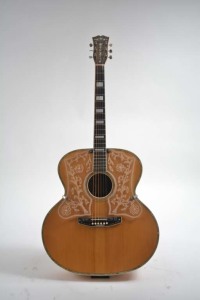
On the other hand, just look around you here – there’s Tony Mottola’s Gibson Super 400 7-String in beautiful condition! And that white one there is a Martin prototype built for Eric Clapton. The one to the right of that is a late edition that was made by the Larson Brothers and strongly believed to have been used, owned and played by Django Reinhardt. It’s from the late Scott Chinery’s collection – which was over 700 guitars and considered the finest collection of guitars in the world. His widow was confronted with the overwhelming task of disposing of them, which in time she sold privately. Anything that has the Chinery connection is a big deal, as the man had impeccable taste in what he acquired. Of the handful of guitars she retained, this was one. Our including it came as a result of people pointing to this event as a showcase of examples of the work by Larson Brothers, which has been an overlooked brand of very, very fine quality instruments. So to put the Larson Brothers best foot forward they reached out to her to see if she would be willing to part with it. It has a wonderful provenance with evidence to support it was Django Reinhardt’s.
EM: In this auction you have guitars owned by living legends—George Benson, Eric Clapton, Eddie Van Halen—and you have one of the late Stevie Ray Vaughn’ guitars. Does that bring a different kind of buyer?
AE: I’ve never known anyone who says, “Now that someone has died, I’m going to buy something I wouldn’t have bought when they were alive.” Included in the the “Delaware Collection” of the auction (and we didn’t know it when we took these items in) we have we have things from both David Bowie and Glenn Frey.
EM: If an item doesn’t have the level of established provenance you and your staff want to see, do you help the consignee obtain it?
AE: In this auction we wouldn’t be shocked to end up with close to 400 lots, and you don’t have the time to do as much investigation as you might like. The nice thing is that the Internet lets you move at lightning speed, compared to the past. So we do what we can do. I once spent six months tracking down some works of art by Picasso, essentially unknown, before ever making an offer of it to anyone. Was it legitimate? Did he do them? So yes, sometimes we take on the researcher/detective roll.
EM: The Concert for New York Guitar, signed by the artists, has to be very desirable. Do you find that certain events bring an emotional pull to an item being auctioned, more so than the same signatures would bring if not tied to that event?
(He shows a New York Times front-page photo of a Guernsey’s Jazz at Lincoln Center auction)
AE: That was our auction of things from legendary figures from the world of jazz. To get a sense of the emotions at that event, this event followed days of previewing that were so crowded you couldn’t move. When the time for the auction came, I went to make opening remarks and Theolonius Monk’s son – T.S. Monk – asked if he could speak. He pointed upwards with his finger and when the crowd quieted, they looked up to see what he was pointing to. He said, “My Dad, Theolonius, is up there somewhere… laughing his ass off because you people are about to pay huge amounts for his old junk!” It was charming, it was funny, and it was teary thing to say, but from the heart. It gave a sense to what this auction was all about. It wasn’t a snobby, snooty “available only to the wealthy event.” It was for the people who loved jazz. It was great. We see that in many of our auctions. We try to make these human events.
In preparation of this event, I had gone to Philadelphia to meet with a woman named Mary. She was a retired schoolteacher living on a pension. She was the “Cousin Mary,” the subject of the song written by John Coltrane. When Coltrane was a teenager heading to New York, he lived for a few years with her family. She brought out a dusty cardboard shoebox and said it had been under her bed for the past 40 years, and would it mean anything to the people at the auction? And could I include it? I opened up the box and inside was a thick roll of paper that was handwritten music, written by John Coltrane as a teenager. I told her it would mean a great deal!
We brought her to the event and at least a half a dozen times she received standing ovations from this crowd… for being the custodian, keeping the faith, if you will, of what meant so much to so many people. And she got a million dollars, more or less, from the sale, page by page. She did phenomenally well.
There are a lot of inside stories of things that go on. To the outside, it’s people making money. But it’s really so much more than that.
NOTE: Mark your calendar: Guernsey’s is planning The Duke Ellington Auction in the Spring – which will feature some more amazing surprises.


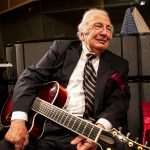



Be the first to comment!